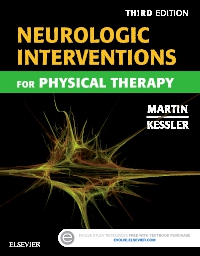
Neurologic Interventions for Physical Therapy - Elsevier eBook on VitalSource, 3rd Edition
Elsevier eBook on VitalSource

Covering the physical therapist and physical therapist assistant’s roles in neurologic rehabilitation, Neurologic Interventions for Physical Therapy, 3rd Edition helps your students develop skills in the treatment interventions needed to improve the function of patients with neurologic deficits. It provides a solid foundation in neuroanatomy, motor control, and motor development, and offers detailed, how-to guidelines to rehabilitation procedures. Case studies help in following best practices for the treatment of children and adults with neuromuscular impairments caused by events such as spinal cord injuries, cerebral palsy, and traumatic brain injuries. The clear market leader for PTA programs, this text also provides excellent preparation for the neurological portion of the PTA certification exam.
Newer Edition Available
Neurologic Interventions for Physical Therapy - Elsevier eBook on VitalSource
-
- Comprehensive coverage of neurologic rehabilitation explores concepts in neuroanatomy, motor control and motor learning, motor development, and evidence-based treatment of adults and children with neuromuscular impairments.
- Case studies demonstrate the patient examination and treatment process, and show how to achieve consistency in documentation.
- Over 700 photos and drawings clarify concepts, show anatomy, physiology, evaluation, and pathology, and depict the most current rehabilitation procedures and technology.
- All-NEW Evolve resources for instructors include video clips of interventions as well as gait and proprioceptive neuromuscular facilitation (PNF), PowerPoint® slides, and a test bank with rationales for correct answers.
- UPDATED Evolve resources for students include an intervention collection, study tips, and additional review questions and interactive case studies.
- Proprioceptive Neuromuscular Facilitation chapter describes how PNF can be used to improve a patient’s performance of functional tasks by increasing strength, flexibility, and range of motion — key to the treatment of individuals post stroke.
- Use of language of the APTA Guide to Physical Therapist Practice ensures that students understand and comply with best practices recommended by the APTA.
- Illustrated step-by-step intervention boxes, tables, and charts highlight important information, and make it easy for students to find instructions quickly.
- Review questions are included at the end of each chapter, with answers at the back of the book.
-
- NEW photographs of interventions and equipment reflect the most current rehabilitation procedures and technology.
- UPDATED study resources on the Evolve companion website include an intervention collection, study tips, and additional review questions and interactive case studies.
-
SECTION 1: FOUNDATIONS
1. The Roles of the Physical Therapist and Physical Therapist Assistant in Neurologic Rehabilitation
2. Neuroanatomy
3. Motor Control and Motor Learning
4. Motor Development
SECTION 2: CHILDREN
5. Positioning and Handling to Foster Motor Function
6. Cerebral Palsy
7. Myelomeningocele
8. Genetic Disorders
SECTION 3: ADULTS
9. Proprioceptive Neuromuscular Facilitation
10. Cerebrovascular Accidents
11. Traumatic Brain Injuries
12. Spinal Cord Injuries
13. Other Neurological Disorders
Answers to the Review Questions


 as described in our
as described in our 